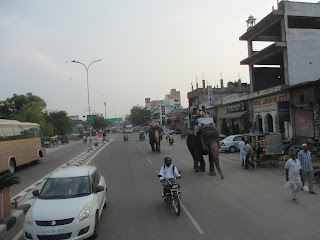Leaving the Amber Fort
The sculpture of the children is wonderful!
Printing fabric
I got to print a bit of cotton!
all the blocks that were used to make the little colorful elephant. I wish we would have been able to keep the elephant, but they said no.
Who these ladies were or what they were doing was not ever mentioned. They may be putting the binding on the carpets
The rug/fabric company had us take our shoes off so we could feel how wonderful these carpets really were. They had many different fibers. Camel, wool, cotton, silk and blends.
Hawa Mahal, palace of the wind.
The packed streets.
Up close of a Holy Cow
The Jantar Mantar, as promised in the last blog, here is the information bit
There are plenty of observatories all over the world, but the Jantar Mantar is considered to be one of the largest observatories ever built. Combining religion, science and art, the Jantar Mantar is the name given to a series of five, magnificent structures built in Jaipur, New Delhi, Ujjan, Varanasi and Mathura. Jaipur was the seat of Maharaja Jai Singh II during the 1720's and this is when this magnificent structure was built here. The Jantar Mantar in Jaipur is considered to be the largest of the five observatories and also houses the world's largest sundial. The Universe and the Cosmos have always been of interest to man, and it was this interest that compelled the Maharaja to build an astronomical observatory. The term 'Jantar Mantar' is derived from the Sanskrit terms 'Yantra' and 'Mantra' meaning 'instruments' and 'formula' respectively. The term 'Yantra' was replaced with 'Jantar' which means 'magical'. The Jantar Mantar houses various architectural and astrological instruments that have caught the interests of astronomers, historians and architects around the world.
History
Maharaja Jai Singh II, the founder of the 'pink city', was a great scholar and an avid astrologer. He studied philosophy, astrology, architecture and religion in various schools, and was also well versed with universal mathematical concepts such as Euclid's Clements, Ptolemy's Syntaxes and the Master works of Aryabhatta. In the year 1718, he wanted to construct an observatory of renown. For this, he studied the subject of astronomy and then built five different observatories around North India. At these places, he would sit with other scholarly astronomers, such as Pt. Kedarnath, for astronomical observations. The 'Jantar Mantar' at Jaipur, being the biggest conservatory in the country, was renovated time and again and houses various instruments that offer precise measurements of time, the azimuth, declination of the sun and the positions of constellations, along with several other astronomical phenomena. The Jaipur observatory was functional for seven years only, as the Maharaja was not very successful in deriving accurate, astronomical observations.
Architecture
The astronomical observatory consists of fourteen major geometric devices for measuring time, tracking constellations and, even for, observing the orbits around the sun. Popular structures within the Jantar Mantar are the 'Samrat Yantra' (the world's largest sundial), the 'Hindu Chhatri', the 'Jaiprakash Yantra' and various geometric structures with astronomical devices to probe the 'universe'.
The City Palace:
Information Bit from Jaipur.org
Located in the heart of the Pink City Jaipur, the City Palace was where the Maharaja reigned from. This palace also includes the famous 'Chandra Mahal' and 'Mubarak Mahal', and other buildings which form a part of the palace complex. The palace is located towards the northeast side of central Jaipur and has many courtyards and buildings. The palace was built between 1729 and 1732 AD by Sawai Jai Singh II. He ruled in Amer and planned and built the outer walls of the palace and later rulers added to the architecture of this palace. These additions have been known to take place right up to the 20th century. The urban layout of the city of Jaipur was commissioned to Vidyadhar Bhattacharya and Sir Samuel Swinton Jacob. The architectural styles are largely based on a fusion of Rajput, Mughal and European styles. Today, the 'Chandra Mahal' has been turned into a museum which is home to unique handcrafted products, various uniforms of the rulers and many more things pertaining to the royal heritage of the City Palace.
History Of City Palace
Maharaja Sawai Jai Singh II is known to have commissioned work for building the outer wall of the city's complex. He shifted from Amer to Jaipur due to water problems and an increase in population in 1727. He had entrusted the city's architectural design to the chief architect Vidyadhar Bhattacharya. The architect went on to design the City Palace in accordance with the Vaastushastra texts.
Architectural Layout
The City Palace reflects Rajput, Mughal and European architectural styles although the palace was designed to Vaastushastra treatise. Some of the famous gates are the 'Udai Pol', 'Jaleb Chowk', 'Tripolia Gate' and 'Virendra Pol', which also happen to be the various entrances to the palace. These are all richly decorated. The Palace has been designed according to a 'grid style' and houses various structures such as, 'Chandra Mahal', 'Mubarak Mahal', 'Diwan-I-Khas' and the 'Govind Dev Ji Temple. The walls and gates are ornately designed to Mughal style, with various murals, lattice and mirrors adorning them from sides.
After the City Palace we went to a jewelry store.
This is a man polishing stones by hand.
Raw minerals, polished into beautiful stones
To me the store itself was not the quality for the price I wanted to pay. We did not buy anything there. We found a wonderful tiny jeweler in the hotel, and I bought two rings and two earrings there. It was so fun to shop with a few friends, we giggled and cajoled each other into getting what we really wanted.
Elephants on parade
Camels
He looks like he was posing!
we found this amusing
Our day is over in Jaipur. Our next day is mainly airports





































No comments:
Post a Comment